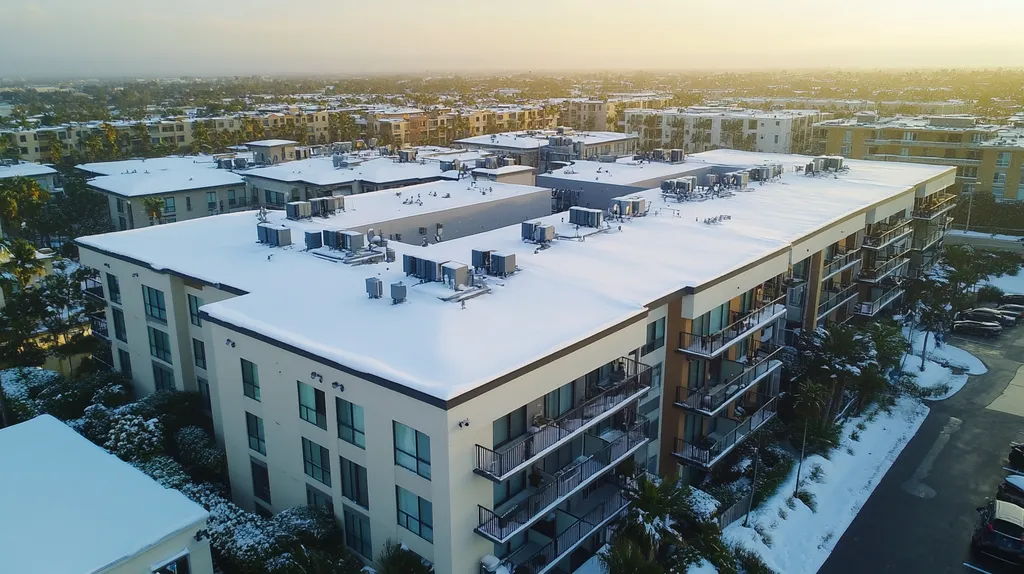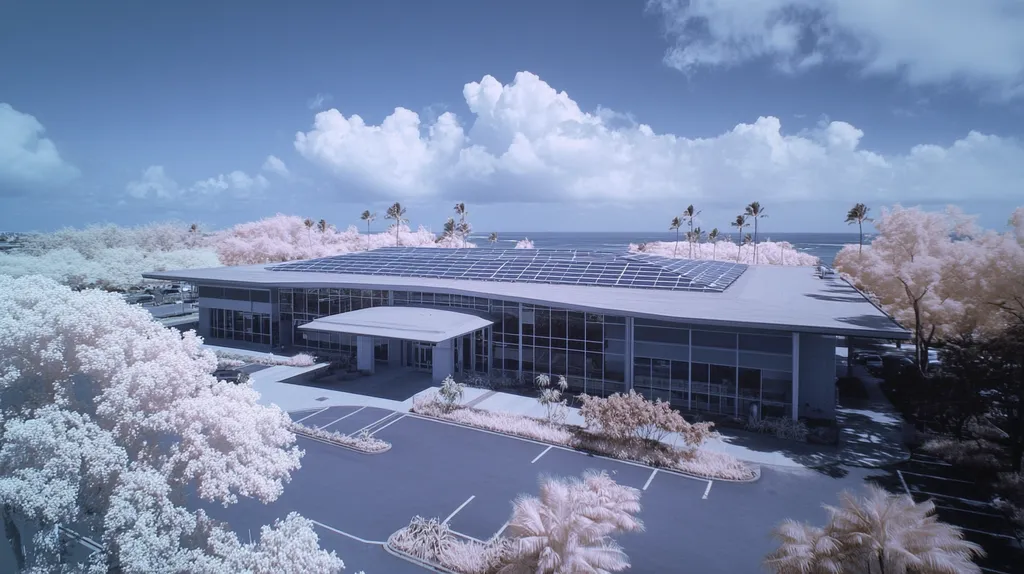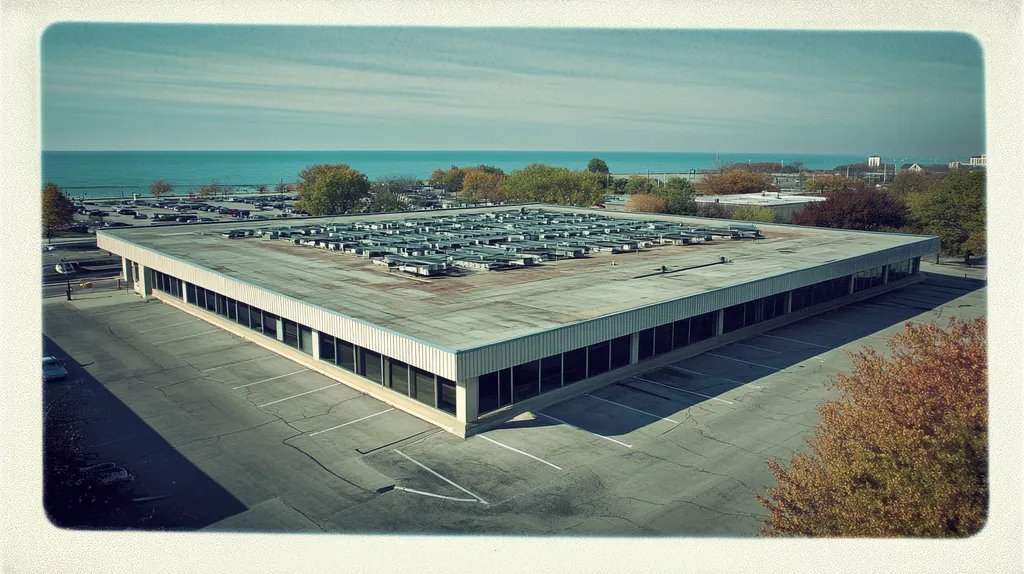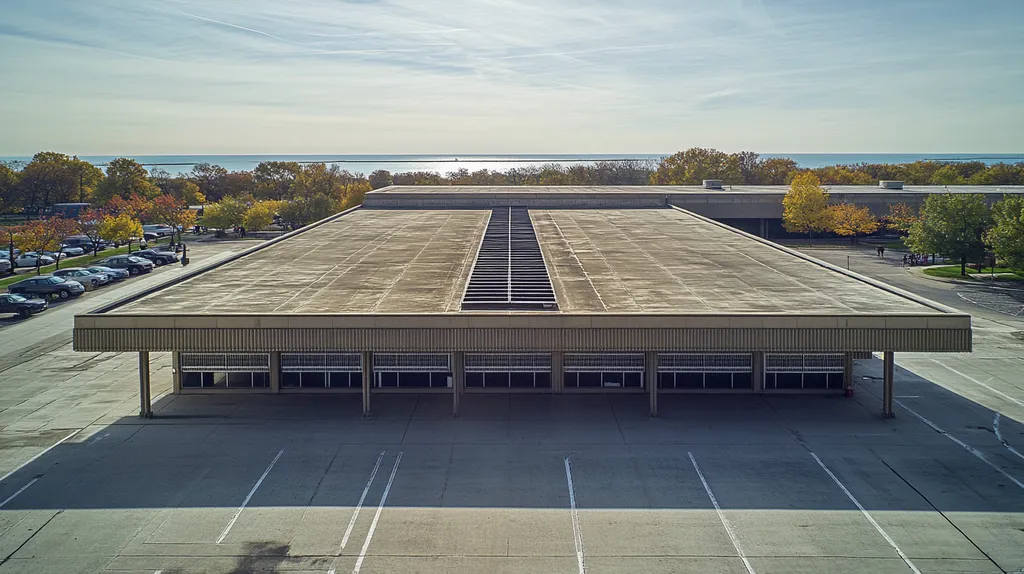Every year, commercial property owners lose millions due to inadequate roof guarantees, with the average repair bill hitting $50,000 when warranties fail. Yet many continue treating these critical documents like routine paperwork.
In an era where a single roof leak can shut down operations for weeks, understanding commercial roof guarantees isn’t just smart business—it’s survival. The maze of coverage options, maintenance requirements, and technical jargon can overwhelm even seasoned facility managers.
This comprehensive guide cuts through the complexity, delivering clear answers about protection options while exposing common pitfalls that leave businesses vulnerable. From basic terminology to advanced decision frameworks, we’ll explore how to secure your investment without falling for overpriced “premium” coverage that underdelivers.
SECTION 1: THE BASICS EXPLAINED
Grasping the concept of a commercial roof guarantee is non-negotiable for business owners. Ignoring it? That’s like playing poker with your building’s future. A roof lacking proper protection opens the floodgates to water damage, structural catastrophes, and a lifespan that could rival a houseplant. You could be looking at repairs soaring past $50,000 in just a few years. This section breaks down what a commercial roof guarantee is, why it’s essential, and how it operates, so property managers can steer clear of costly missteps in facility management.
What It Is (In Plain Language)
A commercial roof guarantee is a binding promise from your roofing contractor or manufacturer, ensuring the roof performs admirably under typical conditions for a set duration. Think of it as insurance against leaks and defects, covering both materials and workmanship.
Guarantees typically last anywhere from five to thirty years, depending on the roofing material and type. Some manufacturers sweeten the deal with extended warranties for high-tech systems, like those fancy energy-efficient roofs. Knowing the details equips you to assess your roof’s reliability.
But don’t just skim through the fine print—understanding what’s covered is vital. Many guarantees come with exclusions that could leave you high and dry, particularly when it comes to natural disasters. Being diligent now can save you a world of headache later.
Also, keep an eye on maintenance requirements, as neglecting them can void the warranty. Routine inspections and maintenance aligned with the specified guidelines can be the difference between keeping your guarantee or facing future expenses.
Why It Matters (To Your Building)
The importance of a commercial roof guarantee is monumental. A solid guarantee directly reinforces your building’s structural integrity and serves as a strategic asset. Ditching the guarantee? That’s a gamble that could usher in an avalanche of unplanned costs due to roofing failures.
Your roof is your frontline defender against the elements, and any damage can lead to operational disruptions and even safety hazards. Investing in a reliable guarantee offers invaluable peace of mind and protects your bottom line.
Moreover, properties boasting robust roof guarantees often score higher during inspections and appraisals. This can significantly influence insurance rates and resale value—giving you leverage when potential buyers see a well-maintained roof.
On top of that, many lease agreements explicitly require landlords to uphold proper maintenance and warranties for their roofs. Skipping out on these obligations could lead to legal complications, making it crucial for property owners to prioritize roof guarantees.
How It Works
Think of a commercial roof guarantee as a legal contract delineating the terms and conditions of coverage. Once the roofing job is done, the guarantee comes into play to shield the owner from specific issues that may crop up.
Most guarantees include clear instructions for filing claims. For example, if a leak is discovered, the owner must notify the contractor quickly and adhere to the repair guidelines. Failing to do so may result in voiding the warranty—definitely not the route you want to take.
Additionally, most guarantees come with maintenance stipulations, such as regular inspections and prompt repairs. Keeping diligent records can aid in filing claims and showing compliance with the warranty conditions.
Beyond just covering repair costs, some guarantees may also stipulate replacement clauses for extreme situations, like severe weather events. Grasping these details is essential for ensuring your investment remains protected.
SECTION 2: PRACTICAL APPLICATIONS
Understanding commercial roof guarantees isn’t just a good idea—it’s essential for safeguarding your investment. Each year, a staggering number of businesses face roof-related issues, resulting in costly repairs and operational hiccups. Smartly applying a roof guarantee can significantly mitigate these risks, extend the lifespan of your roofing system, and provide peace of mind for property managers. In this section, we’ll explore practical examples, identify critical times to activate your guarantee, and discuss how roofing interacts with other building systems.
Common Uses & Examples
Commercial roof guarantees can be found across various industries, from retail to manufacturing and warehousing. For example, a big-box retailer might choose a flat roofing system backed by a 20-year guarantee, a smart move that helps prevent leaks and deterioration from becoming a massive financial headache.
In industrial settings, metal roofing is popular among manufacturing plants, leveraging warranties to ensure the roofs withstand the rigors of heavy machinery and environmental challenges. These guarantees cover both materials and workmanship, allowing business owners to reduce long-term costs significantly.
The key takeaway? Choose a reputable roofing contractor who understands the ins and outs of commercial guarantees. Regularly reviewing your guarantees is equally important. Proactive management means minimizing future risks and financial burdens.
When You Need It Most
Many commercial property owners only recognize the importance of roof guarantees in hindsight—usually after a weather disaster strikes. Damage assessments all too often reveal roofing failures linked to lacking or expired guarantees, leading to unexpected expenses and operational downtime.
It’s best practice to secure guarantees at the initial roof installation or during major repairs. The longer a roof operates without a guarantee, the greater the risks of serious damage and loss.
Seasonal weather shifts can also signal the urgent need for a robust roof guarantee. Heavy rain, snow, or hail without proper coverage can compromise roof integrity. Being proactive with a commercial roof guarantee can prevent costly complications down the road.
Interactions With Other Systems
A commercial roof is part of a larger ecosystem—its performance directly affects other building systems. For instance, leaks can lead to water damage in HVAC units, which can skyrocket energy costs and impair equipment functionality. This only reinforces the necessity of an effective roof guarantee.
Moreover, roofing systems must work in tandem with drainage solutions to prevent pooling water, which can severely shorten a roof’s lifespan. Guarantees that include drainage management provide added value, enhancing overall building performance and energy efficiency.
Lastly, consider how roof maintenance relates to overall facility operations. Regular inspections not only keep business owners informed but also maximize the advantages of roof guarantees. Understanding these interactions can translate into significant savings for businesses in the long haul.
SECTION 3: KEY TERMINOLOGY DECODED
Knowing your roofing terminology is like having a treasure map—it’s essential for navigating the complex world of commercial roofing. Misunderstandings can turn simple repairs into financial fiascos or create squabbles between property managers and contractors. This section deciphers crucial terms, demystifies industry jargon, and simplifies measurement units, empowering business owners to make informed choices.
Essential Terms Explained
When it comes to commercial roofing, some commonly used terms can lead to eyebrows being raised. Take “warranty,” for instance. It’s not just a simple promise from the manufacturer about the roof’s performance; it often includes maintenance obligations as well. Knowing the length and specifics of your warranty gives you the clarity to understand how much financial protection you actually have.
Another term to know is “flashing.” These materials are crucial in keeping water from sneaking into vulnerable spots like joints or chimneys. If flashing isn’t installed correctly, leaks can creep in and invalidate your warranty—definitely not the scenario any owner wants to face.
Then there’s “membrane,” which acts as your roof’s moisture barrier. Different types, like EPDM or TPO, come with unique characteristics. Understanding these differences can directly impact decisions on the cost, energy efficiency, and lifespan of your roof.
Ultimately, grasping these key roofing terms lets property owners communicate more effectively with roofing professionals, leading to informed decisions that protect their investments.
Industry Jargon Translated
The world of roofing comes with its own set of jargon, which can sound like a foreign language. For example, “R-value” measures how well a roof resists heat transfer. A higher R-value means better insulation, which can translate into lower energy bills over time—something every savvy business owner should care about.
The term “slope” indicates the angle of the roof surface and is crucial for effective water drainage. Without the proper slope, roofs are susceptible to early damage, which can lead to headaches down the line. Understanding how to communicate about slope can be key when discussing roof design with contractors.
Deciphering this jargon helps property managers make sound decisions and fosters clear communication with roofing professionals.
Measurement & Units Simplified
Getting measurements right is essential for any roofing project. The most common unit of measurement is square feet, which tells you how much area needs covering. Knowing the total square footage of your roof is critical for determining the amount of materials required, helping avoid budget-busting surprises.
When talking about roofing materials, a “square” refers to a 10×10 foot space—or 100 square feet. This terminology is vital for accurate estimates and planning in roofing projects. A mix-up in units can lead to costly miscalculations.
Another crucial metric is “pitch,” which describes the roof’s angle. This affects everything from drainage efficiency to material selection. Modern roof designs can change pitch, impacting aesthetics and waterproofing effectiveness.
By clarifying these measurements and terms, property owners arm themselves with the knowledge necessary to navigate roofing contracts and projects with confidence.
SECTION 4: DECISION FACTORS
When it comes to selecting a commercial roof guarantee, decision-makers must tread carefully or risk sinking their budgets and future maintenance plans. According to current industry data, the wrong choice can inflate operational costs, leaving businesses with maintenance expenses that can soar up to 30% higher. For property owners and facility managers, it’s crucial to unravel the intricate factors surrounding roofing decisions. This section will dive into cost considerations, performance trade-offs, and vital aspects of lifespan and durability.
Cost Considerations
At first glance, the initial price of a roofing system may appear to be the most pressing concern. But opt for the cheapest option, and you might be in for an unpleasant surprise. While lower upfront costs may be enticing, they often lead to higher long-term expenses due to ongoing repairs and replacements. This makes understanding the total cost of ownership essential for making a smart investment.
Take, for instance, a flat roofing system that may boast a budget-friendly price tag compared to its sloped counterpart. It may, however, demand far more in maintenance costs thanks to pesky drainage issues. Don’t forget to include warranty expenses and the potential impacts on insurance premiums if roofing standards aren’t met.
Moreover, investing in a high-quality roofing system can drive down energy costs over time. Properties with durable materials typically enjoy lower energy bills, making that initial outlay much easier to swallow.
In short, balancing upfront costs with long-term financial implications is key to picking a commercial roof guarantee that won’t haunt you down the road.
Performance Trade-offs
When it comes to performance, cutting corners can be a recipe for disaster. The capabilities of roofing materials significantly influence their efficiency and lifespan. Some materials might shout high protection and energy efficiency but, in reality, fall short on durability when extreme weather strikes. Property owners must carefully evaluate specific performance traits before making a choice.
For example, single-ply membranes are popular for their lightweight nature and ease of installation; however, they don’t always handle severe weather as well as built-up systems do. It’s crucial to consider whether the performance level of a chosen material aligns with local environmental challenges.
Additionally, focus on performance metrics that matter, such as resistance to UV rays, wind uplift, and moisture penetration. Overlooking these factors could lead to early roof failure and costly repairs.
Ultimately, finding the right balance between performance and cost is essential for maximizing both immediate benefits and long-term gains.
Lifespan & Durability Factors
The lifespan of a commercial roof hinges on the materials selected and the quality of installation. Choosing a roofing system that’s proven to be durable can significantly cut down on replacement frequency—and the costs associated with it. Materials like metal and thermoset membranes can offer warranties that extend up to 30 years, reflecting their expected longevity.
However, external variables such as location and climate play a critical role in determining a roof’s durability. A product that excels in a temperate climate may buckle under the pressure of severe storms or extreme temperatures elsewhere.
It’s essential for property owners to stay abreast of local building codes and standards to ensure their roofing system meets safety and performance regulations. Opting for a guaranteed product from a well-respected manufacturer adds another layer of assurance regarding durability.
Conducting a thorough assessment of lifespan expectations and installation standards will empower property owners to make informed decisions, safeguarding their investment for many years to come.
SECTION 5: COMMON CHALLENGES
Maintaining a commercial roof is no walk in the park—it’s more like a tightrope act over a pit of flaming financial consequences. According to the National Roofing Contractors Association, neglect can dramatically shorten a roof’s lifespan, potentially costing property owners thousands of dollars in unexpected repairs. To keep their investments safe, property owners need to recognize common problems, be vigilant for warning signs, and embrace preventative strategies. This section zeros in on these challenges and how best to tackle them.
Frequent Problems & Solutions
Leaks, clogged drains, and membrane deterioration are not just minor inconveniences—they can snowball into major disasters faster than one can say “unexpected costs.” Often triggered by severe weather or aging materials, leaks can cause interior damage or mold growth, turning simple fixes into costly renovations. Regular inspections are a must. Catching leaks early allows for timely repairs that will help save the roof and the budget.
Next on the list: poor drainage systems. Blocked gutters can transform a slightly rainy day into a mini Lake Vesuvius on your rooftop, risking serious structural issues. Property owners should routinely check that drains and gutters are clear and consider adding extra drainage solutions for heavier rainfalls—because who wants a swimming pool where the roof should be?
Don’t overlook membrane deterioration, either. Those cracks and tears could spell trouble for older roofing systems. Switching to modern, durable materials like advanced thermoplastics can offer enhanced resistance to UV rays and harsh weather conditions. Consistent maintenance—including proactive inspections and swift repairs—can easily mitigate this looming issue.
In short, regular checks and swift action can address these frequent challenges. A little diligence goes a long way in extending the life of a roof and protecting the bottom line.
Warning Signs To Watch For
Catching warning signs early can save property owners from the wrath of costly repairs. One glaring signal is water stains on ceilings or walls. These unsightly marks often indicate a leak that must be investigated immediately. Ignoring them might lead to further damage—your budget will thank you later.
Pooled water on the roof surface is another red flag. Left unchecked, this can lead to material wear that effectively reduces a roof’s lifespan. Make it a habit to monitor drainage systems to nip these issues in the bud.
Visible cracks or blisters in roofing membranes also signal underlying problems that demand immediate attention. If moisture manages to infiltrate through these openings, expect costly structural damage down the line. Quick actions—like repairing or replacing compromised roof sections—can drastically extend the roof’s life.
Being proactive about these signs isn’t just smart; it’s necessary. Property owners who stay vigilant are likely to save big on extensive repairs while boosting rooftop durability.
Preventative Approaches
Prevention is the name of the game. Proactive maintenance strategies can prevent minor roofing issues from spiraling out of control. Conducting thorough inspections, ideally twice a year, should be a non-negotiable priority for property owners. These evaluations help spot potential problems early, allowing for timely fixes before they turn into major headaches.
A comprehensive roof maintenance plan is equally vital. These plans typically involve regular cleaning of gutters, removing debris, and engaging professional inspectors to catch issues ahead of time. Routine maintenance not only boosts the roof’s performance but can also lower overall insurance costs—everyone loves to save some cash.
Investing in high-quality materials during the installation phase can set the stage for long-term success. Opting for energy-efficient roofing solutions may lead to significant savings over time through improved durability and reduced utility bills. Partnering with seasoned contractors ensures the right materials are selected.
By prioritizing preventative approaches, property owners can effectively safeguard their commercial roofs, ensuring they remain functional and effective. Staying ahead of maintenance reduces disruptions to business operations and solidifies the integrity of the investment.
SECTION 6: NEXT STEPS & RESOURCES
Grasping the ins and outs of a commercial roof guarantee isn’t just nice to have—it’s crucial for shielding assets from costly surprises. A staggering 30% of commercial roofs fail early due to a lack of maintenance and sloppy documentation. Without a solid grasp of your guarantee options and the right questions asked, businesses can find themselves in a financial pickle when the roof starts to crumble.
Questions To Ask Providers
Engaging a roofing provider without the right questions is like walking into a lion’s den without a plan. Start by probing into the specifics of the guarantee. What exactly does it cover? Are there sneaky exclusions hidden in the fine print? This knowledge will save you from nasty surprises later.
Don’t forget to ask about the guarantee’s duration. Some may sound impressive but may not last as long as you’d hope. Also, find out if extensions are an option and under what terms—because who doesn’t want a safety net when things get hairy?
Dig into what is required to maintain the guarantee. Does it include regular inspections? Knowing the ropes here means you won’t find yourself unprotected when it counts the most.
Lastly, consider the guarantee’s transferability. If the business changes hands, a transferable warranty is a golden ticket. It can boost the property’s value, making it worth its weight in gold for future deals.
Industry Standards & Guidelines
Knowing the industry standards isn’t just a recommendation; it’s a necessity for smart roof decisions. The National Roofing Contractors Association (NRCA) lays down solid guidelines that spotlight best practices in roofing.
Understanding what counts as a quality installation and acceptable materials is key. Abiding by these benchmarks lays a strong foundation for any roofing guarantee you choose.
Check if your roofing provider adheres to these standards, as their habits directly influence the reliability of your guarantee. Cutting corners could mean you end up with a failing roof, making that guarantee about as useful as a chocolate teapot.
Staying updated with the latest regulations allows business owners to navigate industry trends effectively. Use this knowledge to make informed decisions based on what’s current and reliable.
Further Learning Simplified
Continuing education on commercial roofing is worth its weight in gold. Several resources distill complex subjects into digestible info for property owners. Online platforms frequently host webinars focusing on roofing guarantees and maintenance tricks of the trade.
Industry trade shows should be on your radar, too. These events are fantastic for absorbing the latest insights from experts on roofing materials, technologies, and guarantee opportunities.
Networking with peers through professional organizations opens the door to shared wisdom and experiences. Engaging with a community can broaden your perspective and solidify your roofing decision-making.
Finally, subscribing to industry publications is a no-brainer. They provide the latest updates and insights on roofing warranties and evolving standards. Stay educated; it’s a smart investment in your commercial future.
The Bottom Line
With commercial roof repairs averaging $50,000 when guarantees fail, property owners can’t afford to misunderstand their coverage options.
The landscape of commercial roofing continues evolving, with new materials and technologies emerging annually, yet the fundamentals of solid guarantees remain constant.
Smart business owners recognize that a roof guarantee isn’t just paperwork—it’s a critical business asset that demands careful attention and strategic management.
By mastering the essentials covered in this guide, property managers can navigate guarantee options confidently, avoid costly pitfalls, and ensure their roofing investments deliver maximum returns.
The time to review your roof guarantee isn’t after a leak appears—it’s now, while you still have options to protect your investment.
FREQUENTLY ASKED QUESTIONS
Q. What is a commercial roof guarantee?
A. It’s a promise from your contractor or manufacturer covering your roof for a set time, ensuring it functions properly under normal conditions. Understanding what’s specifically included in your guarantee can save you from unpleasant surprises down the line. Make sure to pay close attention to exclusions and required maintenance to keep your guarantee intact.
Q. How can I practically apply my commercial roof guarantee?
A. By applying your guarantee proactively, especially during the roof installation and precise timings of repairs, you safeguard your investment significantly. Regularly reviewing your maintenance and guarantee terms can mitigate risks while maximizing your roof’s lifespan. Ignoring these aspects can lead to unexpected costs and headaches.
Q. What key terms should I know about my industrial roof?
A. Familiarizing yourself with terms like “warranty,” “flashing,” and “membrane” is vital. Each term involves specific responsibilities, including maintenance obligations and functional components critical to your roof’s integrity. Understanding these terms allows you to communicate effectively with professionals and makes decision-making much easier.
Q. What decision factors should I consider for a commercial roof?
A. Consider costs, performance trade-offs, and the longevity of the roofing system you select. A great upfront price can often hide much higher long-term expenses if corners are cut on material quality or installation. Balancing immediate expenses with longer lifespan potential will help you make an informed choice.
Q. What common challenges arise with commercial roofs?
A. Common challenges include leaks, drainage issues, and membrane deterioration. Ignoring these challenges often leads to significant repair costs. Regular inspections are key for catching these issues early, ultimately protecting your investment and reducing long-term repair expenses significantly.
Q. How can I educate myself further on commercial roofing?
A. Explore online courses, attend industry trade shows, and subscribe to related publications. Networking with peers can provide valuable insights and experiences. Additional resources, including webinars, offer simplified education on critical topics, allowing you to stay informed and make better decisions.
Q. What are the benefits of a transferable commercial roof guarantee?
A. A transferable guarantee can significantly increase your property’s value, making it appealing to potential buyers. In addition, it provides peace of mind knowing that future owners will benefit from the protection. It’s a strategic advantage in real estate transactions that can turn a ho-hum sell into a hot commodity.











